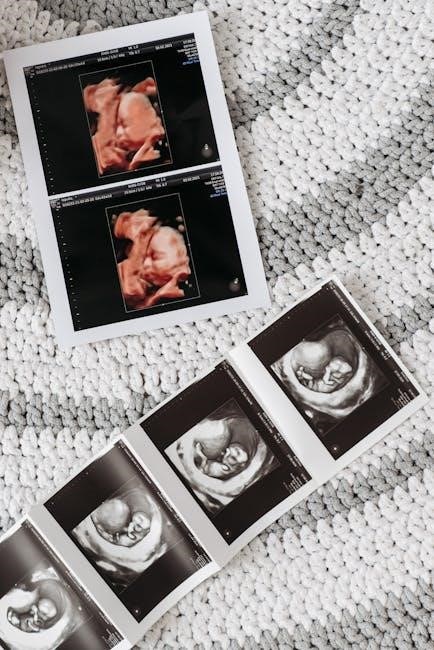CPT codes are standardized codes used to describe medical procedures. They facilitate accurate billing, insurance claims, and data collection. CPT code 76872 refers to transrectal ultrasound-guided prostate biopsy.
What Are CPT Codes?
CPT (Current Procedural Terminology) codes are standardized codes used to describe medical, surgical, and diagnostic procedures and services; Developed by the American Medical Association (AMA), these codes ensure uniform documentation and billing across healthcare systems. Each CPT code represents a specific procedure, making it easier for providers to bill insurance companies and maintain accurate medical records. They are regularly updated to reflect advancements in medical practices and technologies. CPT codes like 76872 are essential for precise billing, ensuring clarity and consistency in healthcare reimbursement processes. They play a vital role in streamlining administrative tasks and facilitating communication between healthcare providers and payers.
Importance of CPT Codes in Medical Billing
CPT codes are crucial for accurate and efficient medical billing. They standardize documentation, ensuring consistency across healthcare providers and payers. By assigning specific codes like 76872 for transrectal ultrasound-guided prostate biopsy, healthcare providers can bill insurance companies precisely, reducing errors and fraud. CPT codes also facilitate quick claims processing, enabling faster reimbursements. They help comply with regulatory requirements and insurance guidelines, ensuring transparency in billing. Additionally, CPT codes aid in data collection and analysis, tracking healthcare services and resource allocation. Their importance lies in maintaining the integrity of medical billing systems, ensuring that procedures are correctly documented and reimbursed. This accuracy is vital for healthcare operations and patient care.

Understanding Transrectal Ultrasound-Guided Prostate Biopsy
A transrectal ultrasound-guided prostate biopsy uses ultrasound imaging to guide a biopsy needle for tissue sampling. It’s a minimally invasive procedure for diagnosing prostate conditions, including cancer.
What is a Transrectal Ultrasound-Guided Prostate Biopsy?
A transrectal ultrasound-guided prostate biopsy is a minimally invasive procedure used to diagnose prostate conditions, including cancer. It involves inserting an ultrasound probe into the rectum to produce images of the prostate gland. Guided by these images, a biopsy needle collects tissue samples for pathological examination. The procedure combines real-time ultrasound imaging with precise needle placement, ensuring accurate tissue sampling; It is commonly recommended for patients with elevated PSA levels or suspicious findings during a physical exam. The use of ultrasound guidance enhances the procedure’s safety and diagnostic accuracy, making it a critical tool in early cancer detection and treatment planning.
Medical Necessity and Indications
A transrectal ultrasound-guided prostate biopsy is medically necessary for diagnosing prostate cancer or other abnormalities when clinical indicators are present. Key indications include elevated prostate-specific antigen (PSA) levels, abnormal digital rectal exam findings, or suspicious imaging results. It is also used to monitor patients with prior prostate cancer or at high risk. The procedure is essential for obtaining tissue samples for histopathological analysis, guiding treatment decisions. Medical necessity is determined by the presence of symptoms or screening results that suggest prostate disease. This minimally invasive approach ensures accurate diagnosis with minimal risk, making it a critical diagnostic tool in urology and oncology. Early detection through this biopsy can significantly improve patient outcomes.

CPT Code for Transrectal Ultrasound-Guided Prostate Biopsy
CPT code 76872 is specifically used for transrectal ultrasound-guided prostate biopsy, a diagnostic procedure essential for detecting prostate abnormalities and guiding treatment decisions accurately.
Overview of CPT Code 76872
CPT code 76872 is designated for transrectal ultrasound-guided prostate biopsy procedures. This code represents a diagnostic imaging service where ultrasound technology is used to guide tissue sample collection. It is essential for evaluating prostate abnormalities, such as suspected cancer. The code applies to real-time ultrasound imaging that directs the biopsy needle accurately. Proper documentation, including the medical necessity and detailed procedure notes, is required for accurate billing. This code is specific to transrectal approaches and should not be used for other biopsy methods or screening purposes. It is a crucial tool for healthcare providers to ensure precise billing and reimbursement for this procedure.
When to Use CPT Code 76872
CPT code 76872 is used when a transrectal ultrasound-guided prostate biopsy is performed. This procedure is typically indicated for patients with elevated prostate-specific antigen (PSA) levels or abnormal imaging findings. It is essential for diagnosing prostate cancer or evaluating suspicious lesions. The code applies when ultrasound imaging is used to guide the biopsy needle during the procedure. It is appropriate for diagnostic purposes, not for screening. Documentation must confirm medical necessity, such as abnormal PSA levels or imaging results. The code should not be used for other biopsy methods or procedures without ultrasound guidance. Proper usage ensures accurate billing and reimbursement for this specific diagnostic service.
Documentation Requirements for CPT Code 76872
Accurate documentation is critical when using CPT code 76872 for transrectal ultrasound-guided prostate biopsy. The medical record must confirm the procedure’s medical necessity, such as elevated PSA levels or suspicious imaging findings. Documentation should detail the ultrasound guidance used during the biopsy, including the number of samples collected. The procedure report must specify that the biopsy was transrectal and guided by ultrasound. Coding records should include the CPT code 76872 for the ultrasound-guided biopsy and any additional codes for imaging or surgical services. Patient consent, physician orders, and pathology results should also be included. Proper documentation ensures compliance with billing guidelines and supports accurate reimbursement.

Billing and Coding Guidelines
Accurate coding and billing are essential for CPT code 76872. Ensure compliance with guidelines, use appropriate modifiers, and document all services to avoid reimbursement issues.
Correct Use of CPT Code 76872
CPT code 76872 is specifically used for transrectal ultrasound-guided prostate biopsy procedures. It is essential to ensure that this code is applied only when the procedure involves ultrasound guidance for prostate tissue sampling. The code should be used when the biopsy is performed for diagnostic purposes, such as suspected prostate cancer or abnormal PSA levels. Proper documentation, including the medical necessity of the procedure, must be maintained. Avoid using this code for non-guided biopsies or procedures that do not involve ultrasound. Accurate coding ensures proper reimbursement and compliance with medical billing guidelines.
Common Modifiers Used with CPT Code 76872
Modifiers are appended to CPT codes to provide additional context. For CPT code 76872, common modifiers include -LT (left side) and -RT (right side) to denote laterality in bilateral procedures. Modifier -59 (distinct procedural service) may be used if the biopsy is performed alongside other procedures on the same day. However, modifiers like -51 (multiple procedures) are generally not applicable. Proper documentation is crucial to justify the use of these modifiers, ensuring accurate billing and compliance with payer guidelines. Always verify payer-specific rules for modifier usage to avoid reimbursement issues.

Reimbursement and Insurance Coverage
Reimbursement for CPT code 76872 varies by payer. Medicare and private insurers typically cover transrectal ultrasound-guided prostate biopsies when medically necessary. Pre-authorization may be required.
Medicare and Private Payer Reimbursement
Medicare and private payers typically reimburse for CPT code 76872 when the procedure is deemed medically necessary. Documentation must justify the biopsy as essential for diagnosis or treatment. Private insurers may have varying coverage policies, and pre-authorization is often required. Medicare reimburses based on established fee schedules, ensuring standardized payment for eligible services. Proper coding and documentation are critical to avoid claim denials. Providers should verify patient eligibility and insurance requirements before performing the procedure to ensure smooth reimbursement processes.
Insurance Eligibility and Pre-Authorization
Insurance eligibility and pre-authorization are critical steps before performing a transrectal ultrasound-guided prostate biopsy. Most payers require pre-authorization to confirm medical necessity, ensuring the procedure aligns with coverage criteria. Patients’ insurance plans must be verified to determine if CPT code 76872 is covered. Private insurers may have specific requirements, while Medicare typically covers the procedure if it is deemed medically necessary. Documentation supporting the indication for biopsy, such as elevated PSA levels or suspicious imaging, must be provided. Failure to obtain pre-authorization may result in denied claims or reduced reimbursement. Providers should ensure compliance with payer policies to facilitate smooth billing and payment processes.

Differentiating CPT Code 76872 from Other Codes
CPT code 76872 is specifically for transrectal ultrasound-guided prostate biopsy, differing from 76942, which is used for vascular procedures, ensuring accurate coding and avoiding confusion.
Comparison with CPT Code 76942
CPT code 76942 is reserved for vascular procedures requiring ultrasound guidance, unlike 76872, which is specific to transrectal prostate biopsies. This distinction ensures accurate billing and avoids coding errors. 76942 involves imaging guidance for interventions like blood vessel access, whereas 76872 focuses solely on prostate tissue sampling. Proper differentiation is crucial to prevent reimbursement issues and maintain compliance with coding guidelines. Using the correct code for each procedure ensures precise documentation and avoids unnecessary claim denials. Always verify the specific use case to select the appropriate CPT code for optimal billing outcomes.
Understanding Ultrasound-Guided Biopsy Codes
Ultrasound-guided biopsy codes are essential for accurately documenting procedures involving imaging guidance. CPT code 76872 specifically pertains to transrectal ultrasound-guided prostate biopsies, distinguishing it from other biopsy codes. These codes ensure precise billing and reimbursement by clearly defining the procedure’s nature and complexity. Proper use of these codes minimizes errors and ensures compliance with medical coding standards. Understanding the specific application of each code is critical for healthcare providers to maintain accurate records and facilitate smooth insurance claims. This coding system plays a vital role in streamline healthcare operations and ensuring proper patient care documentation. Accurate coding enhances transparency and efficiency in medical billing processes.

Clinical Applications and Outcomes
CPT code 76872 is crucial for documenting transrectal ultrasound-guided prostate biopsies, a key procedure in diagnosing prostate cancer. It ensures accurate coding for effective patient outcomes and treatment planning.
Role in Prostate Cancer Diagnosis
Transrectal ultrasound-guided prostate biopsy, coded as CPT 76872, plays a pivotal role in diagnosing prostate cancer. This procedure involves using ultrasound imaging to guide needle biopsies of suspicious prostate tissue. It is the gold standard for obtaining tissue samples to detect malignancy. The accuracy of this method ensures reliable diagnostic results, enabling early detection and timely treatment. By providing detailed imaging, it helps identify abnormalities that may not be palpable. The procedure’s effectiveness in sampling tissue reduces diagnostic uncertainty, making it a cornerstone in urologic care. Accurate coding of this procedure ensures proper documentation, facilitating effective treatment planning and reimbursement. Its role in improving patient outcomes underscores its clinical significance in prostate cancer management.
Effectiveness and Safety of the Procedure
Transrectal ultrasound-guided prostate biopsy is highly effective for diagnosing prostate cancer, offering precise tissue sampling. The use of real-time ultrasound imaging enhances accuracy, reducing diagnostic uncertainty. The procedure is minimally invasive, minimizing complications. Infection rates are low when proper protocols are followed. Common side effects include temporary bleeding or discomfort, but severe complications are rare. The precision of ultrasound guidance reduces the risk of sampling errors. Patient recovery is typically quick, with most resuming normal activities shortly after. This procedure is widely regarded as safe and effective, making it a preferred diagnostic tool in urology. Its safety profile and diagnostic accuracy ensure reliable outcomes for patients.
Accurate coding with CPT 76872 ensures proper billing and reimbursement for transrectal ultrasound-guided prostate biopsies. Future advancements may include improved imaging technologies and minimally invasive techniques, enhancing diagnostic precision and patient outcomes while maintaining procedural safety.
Importance of Accurate Coding in Healthcare
Accurate coding is essential for proper billing, insurance reimbursement, and maintaining patient records. It ensures compliance with regulations, avoids legal issues, and prevents denied claims. Correct use of CPT codes like 76872 guarantees precise documentation of procedures, facilitating efficient data analysis and healthcare planning. This accuracy also supports public health tracking and resource allocation. Proper coding enhances patient care by ensuring procedures are appropriately recorded and billed, maintaining trust and accountability in healthcare delivery. It is crucial for the integrity of medical billing systems and the overall efficiency of healthcare services.
Emerging Trends in Prostate Biopsy Techniques
Advancements in prostate biopsy techniques are transforming diagnostic practices. MRI-guided and MRI-fusion biopsies are gaining traction, offering enhanced precision. Real-time tissue characterization and advanced imaging software improve accuracy. Minimally invasive methods reduce complications. Emerging trends focus on optimizing patient outcomes and reducing risks. These innovations highlight the importance of accurate coding to reflect modern practices. CPT codes like 76872 must evolve to accommodate new techniques, ensuring proper billing and data collection. As technology advances, staying updated on coding guidelines is crucial for healthcare providers. These trends underscore the dynamic nature of medical diagnostics and the need for adaptable coding systems.
